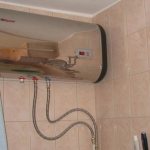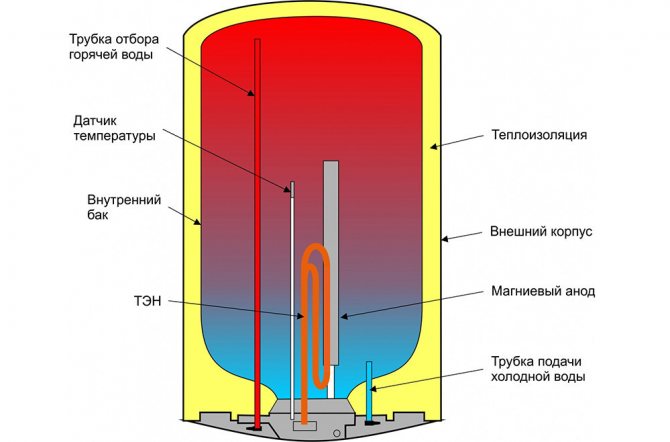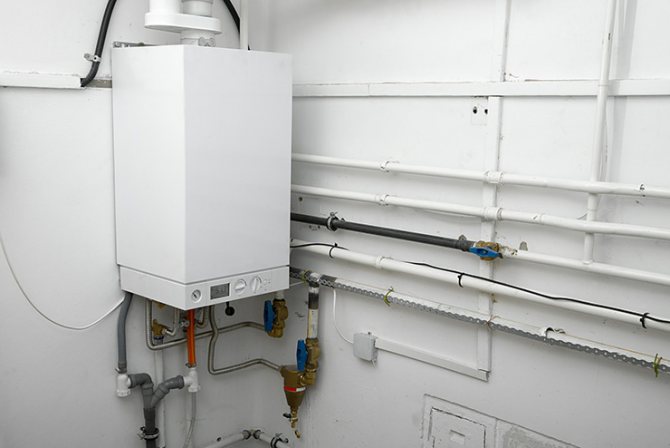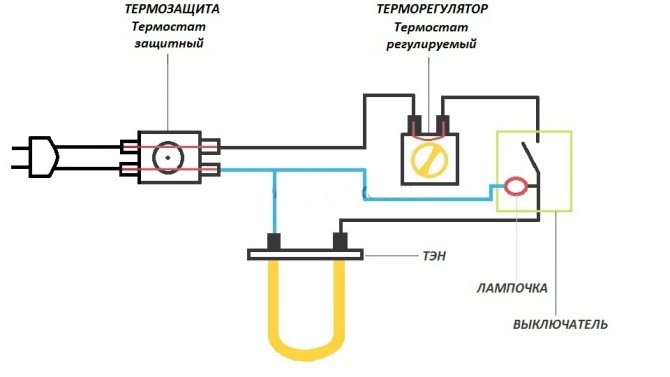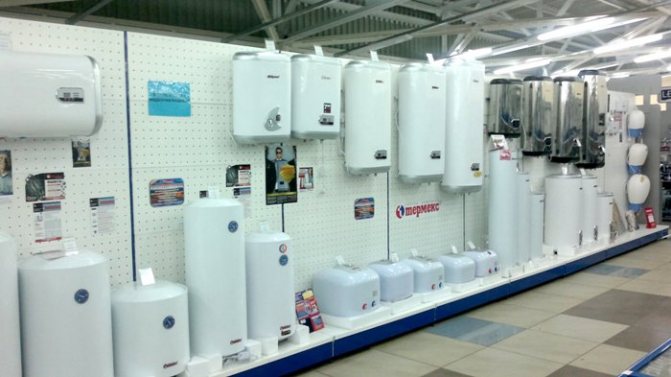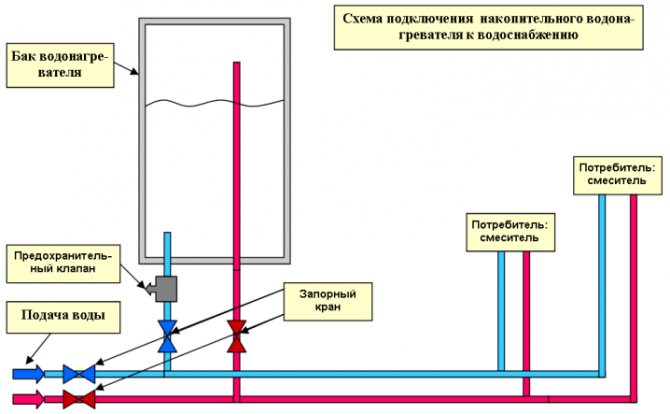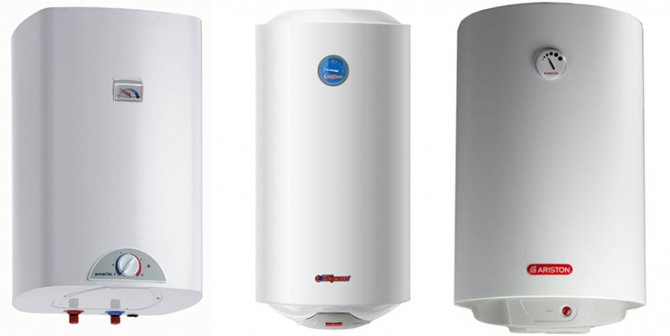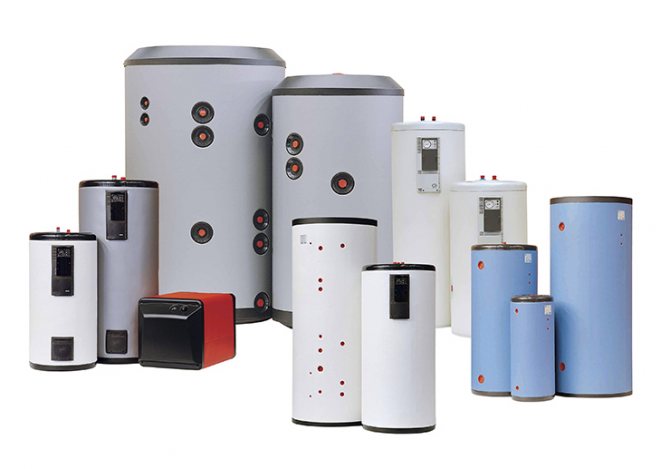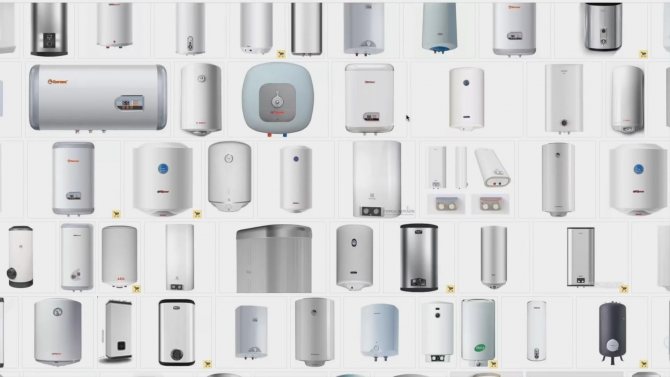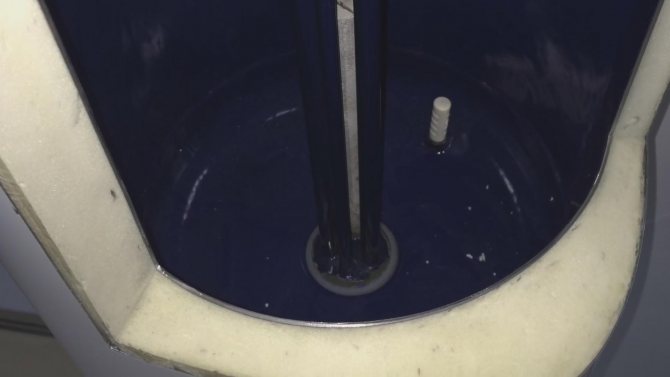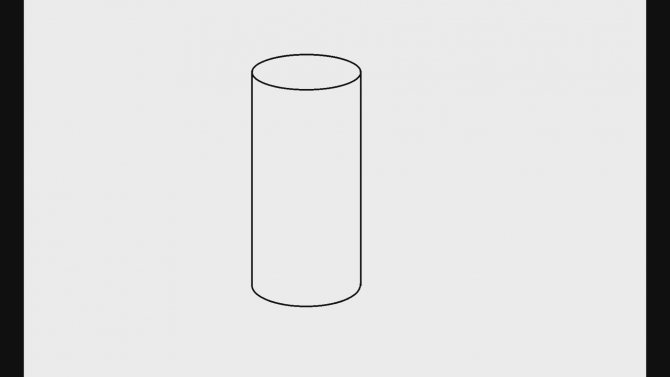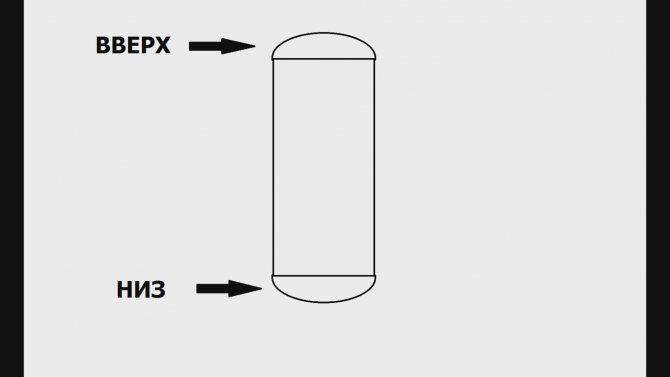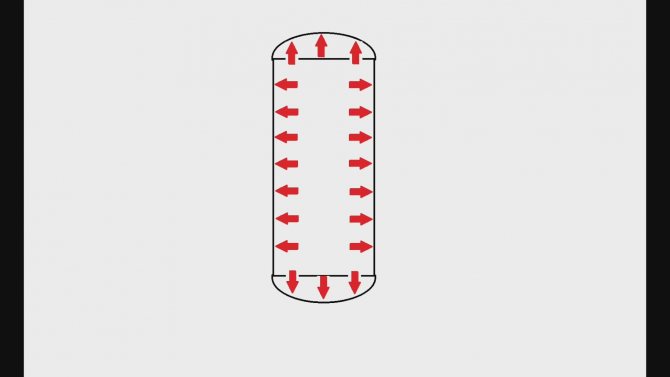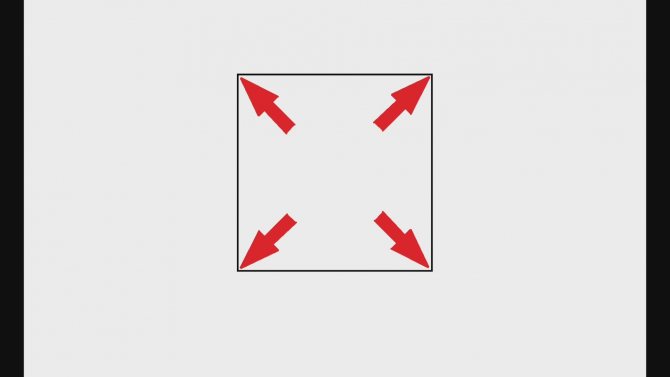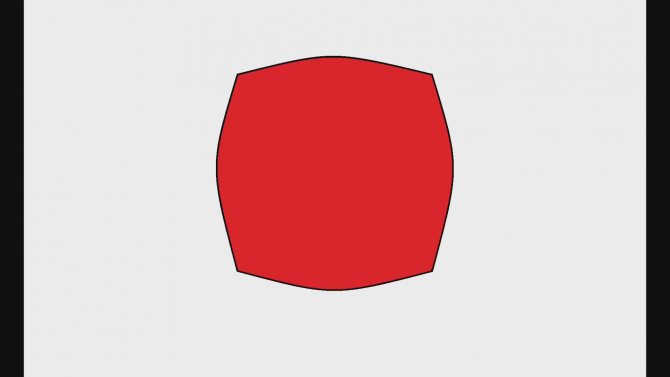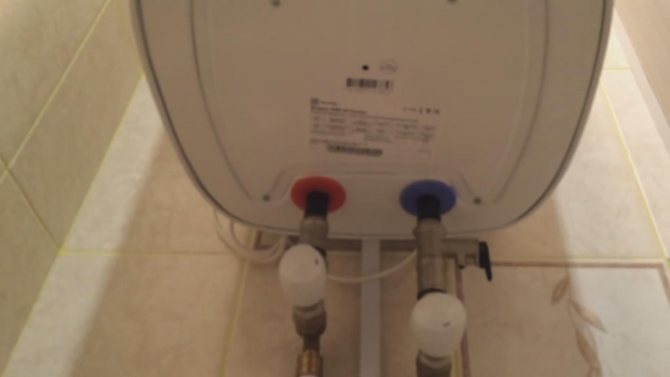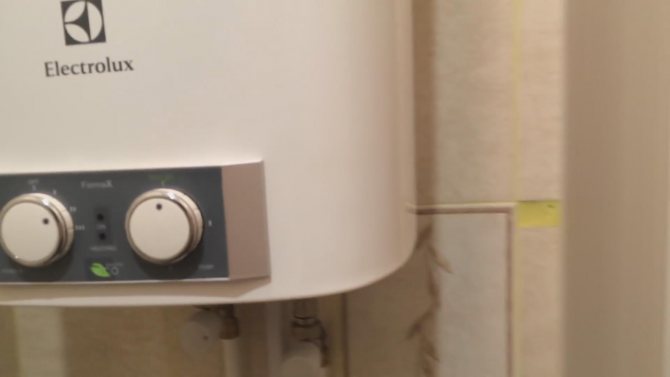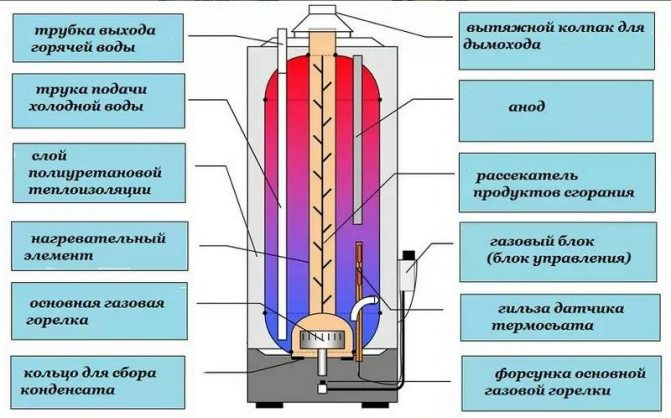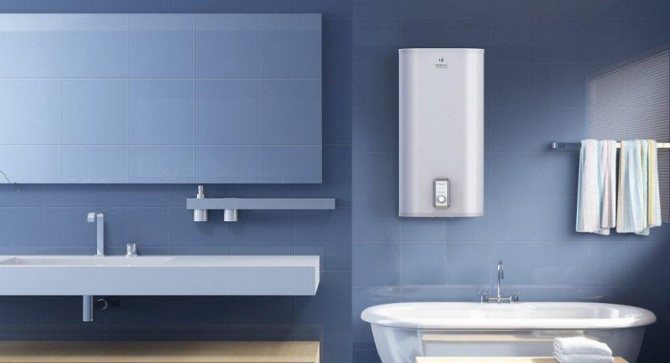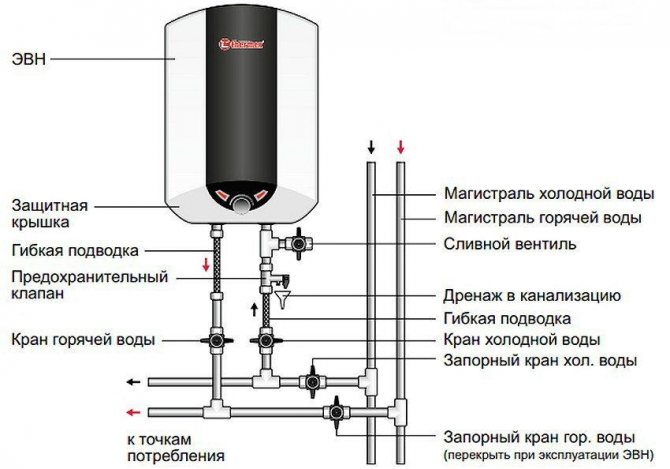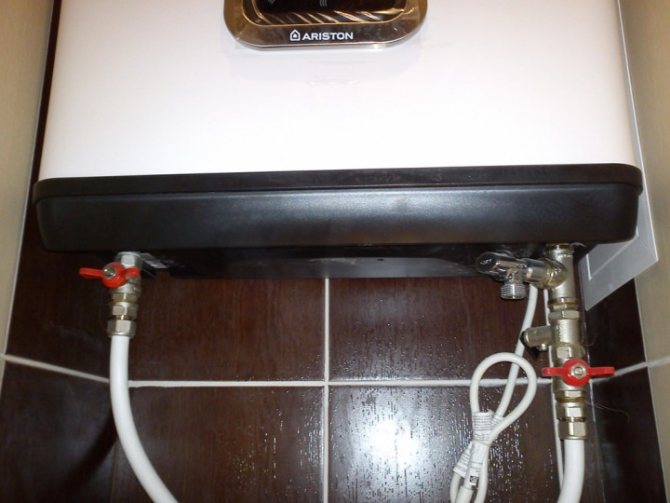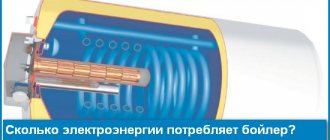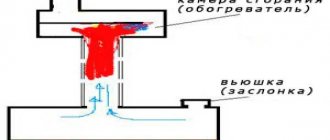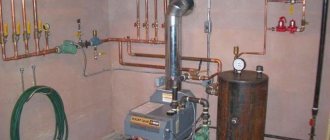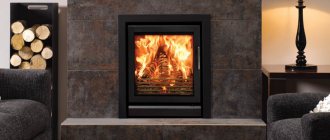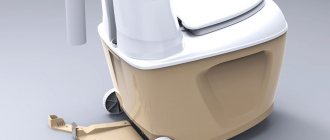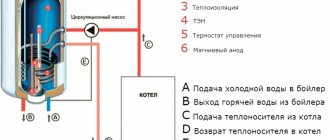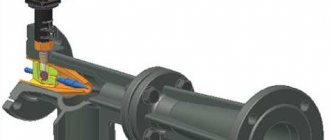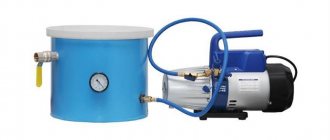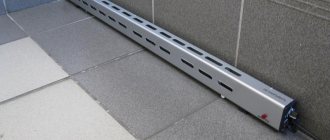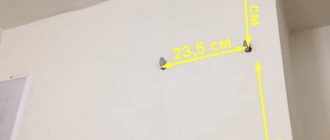Types of electric water heaters
The most economical way to heat cold water is to use a gas water heater, but in most cases this heating device is simply impossible to install. In multi-storey buildings, there are often no special systems for the disposal of natural gas combustion waste, and many private houses and summer cottages are not supplied with gas. Therefore, in this case, the installation of electrical appliances for obtaining hot water has no alternative. All electric water heaters are divided into only two types: storage (boilers) and flow-through. Below we will briefly review the principle of operation of each type separately.
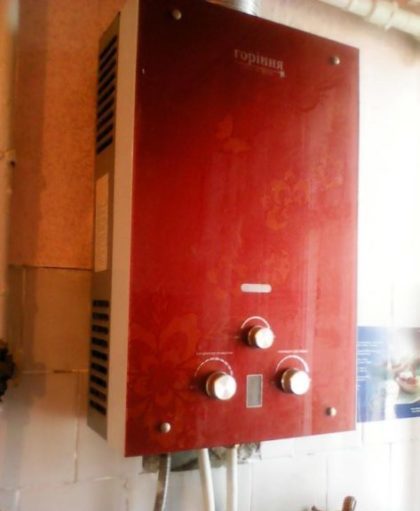
- Electric storage water heater (boiler). This device is most often called a boiler. The device is a simple water tank with installed heating elements (TENs) and electronic or mechanical control systems. The container itself is thermally insulated from the external environment, which significantly saves energy. The principle of operation of the storage water heater is static. The tank is filled with cold water and it is heated by heating elements. The whole process of heating and maintaining the required temperature takes place under the control of the automation unit.
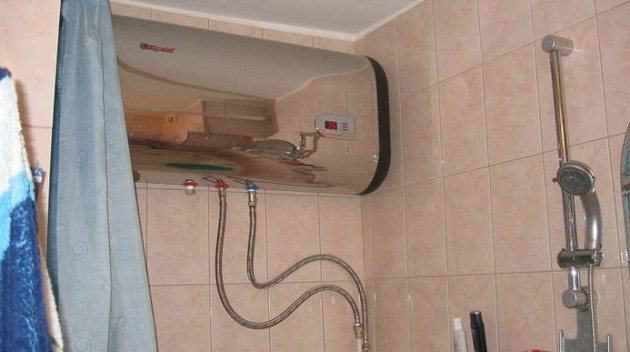

- Flowing electric water heater. The principle of operation of the instantaneous water heater is dynamic. This device does not have a cold water storage tank. The process of heating water by heating elements takes place in special pipes and coils with a constant flow of water through these elements. As in storage systems, in instantaneous water heaters, the principle of mechanical or automatic control using an electronic unit is implemented. For rapid heating of a strong flow of water to the required temperature, the instantaneous electric heater must have sufficient power, which is a definite disadvantage.
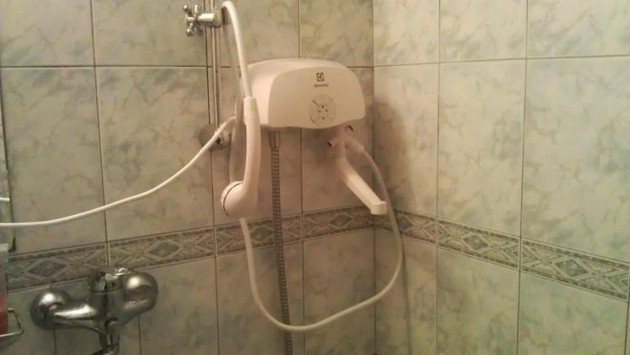

These two types of electric water heaters can have different designs. There are devices with indirect heating, where heat energy is transferred to water through an additional heat carrier in a heat exchange module. In this case, the heating elements heat up a special liquid, which, in turn, transfers heat to the cold water in the heat exchanger. In addition, not only heating elements, but also other devices, for example, infrared sources, can be used as heating elements.
But all these devices are much more expensive, therefore, flow and storage water heaters with direct heating of water by resistance heating elements, that is, heating elements, are mainly used. Below we will take a closer look at the device, the principle of operation, the advantages and disadvantages of both types of electric water heating equipment. This will allow you to make the right choice of a device for uninterrupted supply of hot water to your home, office or utility room.
How to turn on the boiler: types, connection diagram, checking correct operation
Water heaters are used in homes where there is no access to a centralized water supply. The systems are often used in urban environments.
In order for the water heater to work properly, you need to know how to use it.
There are instructions that indicate how to properly turn on the Termeks, Electrolux or Ariston boiler after installation and during operation. The algorithm depends on the type of device and manufacturer.
Boiler characteristics
The boiler is installed as an alternative or main water heating system
All water heaters can be divided into two groups according to the method of water heating: flow and storage.
Accumulative models are equipped with a tank in which water is heated using a heating element. Thanks to the insulation of the tank, the water retains its temperature for a long time. The volume of the tank can exceed 300 liters. Oversized products are used in large country houses. Accumulators with a volume of about 10 liters can be installed in apartments.
Flow models are suitable for domestic use in apartments. Their principle of operation is to heat the liquid when the tap is turned on. These are compact devices that are installed next to the water tap.
By type of fuel, they are distinguished:
- Gas appliances. They are quite expensive, but they pay off in two years of constant use.
- Electrical. The models themselves are inexpensive, but significant electricity costs will be required.
According to the listed characteristics, the owner of a house or apartment chooses which boiler suits him best.
User's manual
Regardless of the type of heater, it is necessary to handle it carefully, carefully and comply with the operating requirements. You can read them in the instructions that come with the package.
Features of the operation of flow models
For the boiler to work longer, it is recommended to install a filter on the inlet pipe.
Differences in devices of different types determine the features of operation. Before starting to use, you need to study the instructions from the manufacturer and perform the following actions:
- Install a coarse filter. It will allow you to collect small debris that falls from water pipes.
- Carry out horizontal installation. Only this type of installation is allowed so that there are no air congestions. Checking is done using a building level.
- If the appliance is electrical, it must be grounded.
Flow models are available with manual and electronic control. The first option is distinguished by its reliability and low cost. Electronic mechanisms are more expensive, but they add functionality.
Before turning on the instantaneous heater for the first time, it is necessary to set the optimal water temperature. It can be adjusted by buttons or by the tap itself, depending on the flow rate. These types of water heaters can be used only at positive temperatures.
The device should be inspected periodically for damage. It is prohibited to use a defective heater. If the appliance is no longer needed to heat the water, it must be removed from the wall, having previously disconnected it from the network and removed the remaining water. Store the water heater in a warm room in winter.
Features of the operation of storage boilers
Storage boiler device with heating element
Models with a water tank vary in size. Large devices are usually wall-mounted or floor-mounted. There are vertical and horizontal types.
Only a device that is correctly configured and connected to the network can be switched on and used. The work must be carried out by a specialist. He also puts a mark on the quality of equipment installation.
After installation, the boiler can be used. Before the first start-up, you need to visually inspect it and make sure that the body and wires are intact. After a successful check, you need to fill the tank with water. To do this, open the water supply valve.
When the tank is full, you can turn on the device and press the power button. Control is performed by buttons on the body or by entering commands on the monitor.
If the boiler is the main source of water, it does not need to be disconnected from the network. A thermostat should be installed so that the heater will only run when needed. When the set temperature is reached, the device will automatically turn off.
Turning on the Termeks boiler
Boilers Termeks are connected by specialists, since it is not equipped with a cord with a plug
The Termeks water heater is connected to the network by specialists. It does not come with a power cord, so a normal user will not be able to connect it. After the water heater is connected, you can proceed to the first start.
Start-up and test instructions:
- Filling the device with water and bleeding air using a tube before switching on. Since the liquid is fed from below and rises upwards, it does not mix.
- Commissioning works. Closing the hot water tap for the entire system.
- Opening the taps on the boiler inlets.
- Opening a hot water tap on the mixer.
- Closing the tap after the appearance of an even and stable flow of hot water.
- Switching on the machine and carrying out the start-up on the control panel.
- Temperature setting. It is necessary to set the Termex boiler to the temperature taking into account the control method - by turning the knob or using a button on the touch screen.
After disconnecting from the network, a factory reset occurs. Therefore, before using the water heater after disconnecting from the power supply, all parameters must be set again.
How to turn on the boiler Ariston
Ariston plugs into an outlet to which grounding must be connected
Step-by-step guide:
- Fill the tank with water.
- Open the hot water valve and wait for the air to escape.
- When water flows out, you need to turn off the tap.
- Set the temperature.
- Connect the boiler to the mains. Wait until the indicator lights up, which signals the start of work and heating.
The heating time for a 50 liter tank is on average 1 hour 50 minutes.
Care and maintenance features
It is periodically necessary to clean the heating element from scale
To operate the heater without problems, the following rules must be followed:
- Provide timely care and maintenance. Models are undemanding, so it is enough to wipe them from dust and dirt with a sponge without detergents.
- Study the operating conditions and observe them.
By following the manufacturer's instructions, you can protect your device from damage.
Individual equipment is installed, started up and maintained only by a specialist. The foreman performs all these works and puts a mark in the warranty card. Otherwise, the user will not receive warranty service and repair.
If a storage boiler is used, work is carried out annually to clean the heating element from scale, the tank from precipitation, and the state of the magnesium anode is assessed. The check is carried out with the boiler disconnected from the network. For long periods of inactivity, drain the water from the tank.
Actions in case of weakening of the pressure
A normally operating device has a constant thrust force. If it looses, it is necessary to clean some of the elements:
- Strainer or coarse filter. He could get clogged with small debris, because of which water does not enter the tap.
- Aerator tab.
- Shower head insert. This part is not installed in all devices.
Parts may only be removed and cleaned when the power outlet is unplugged.
Possible problems and solutions
Changes in water temperature can be caused by thermostat breakage
During the operation of boilers, certain problems may arise. This is usually an unpleasant odor and mold. They can appear when the heating temperature is set to 40 ° C.
Setting such values is beneficial from the point of view of saving energy, but it is in such conditions that bacteria and fungi actively multiply. To eliminate the problem, it is necessary to set the temperature regime at the level of 50-55 ° С.
In each model, the meaning is called eco-mode.
When operating the device, do not connect to a hot water pipeline. The device may be damaged. Average temperatures depend on the type of model.
When the flow of warm water from the flow heater stops, you can judge about pressure problems. Some devices are equipped with a low pressure mixer. If it is selected incorrectly, the water is turned off. To resume the fluid supply, the pressure must be normalized. The reason may be the shutdown of the water supply. It needs to be renewed.
Too hot water may flow from the tap. This is due to the knocked down temperature control settings. If the device has a manual adjustment mechanism, you need to set the optimal values yourself. To set up electronic models, a wizard call is required.
Any changes in water temperature can be associated with a breakdown of the thermostat. To replace it, you must call a specialist.
Storage water heater
The storage water heater device is quite simple. The main element of the device is a water tank made of stainless steel or aluminum. If the tank is made of plain steel, then its inner surface of the tank is coated with special materials that improve its performance and corrosion resistance. A heating module is installed in the storage tank, consisting of one or several heating elements. Heating elements can be "wet" or "dry". In the first case, the heating element is in direct contact with water, and in the second, it is placed in a tube that heats the water.
This whole structure is placed in an outer casing and insulated from it with a special thermal insulation material. A thermostat and other necessary sensors are installed in the tank, connected to the automation system and information modules. A control system, mechanical or electronic, is mounted on the outer shell of the device. Below is a classic diagram of a storage water heater in section with the minimum required set of elements.
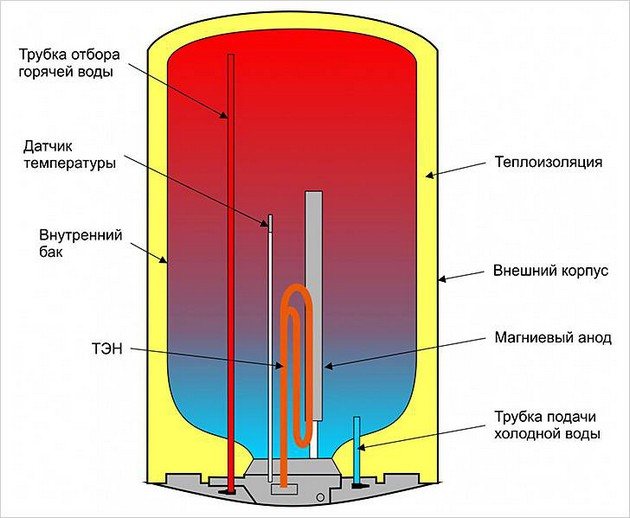

How does a storage water heater work? It's pretty simple! The principle of operation of the boiler is based on the properties of water with different temperatures. As we know from the school physics course, a warm liquid tends upward, and a cold one - downward. It is on this physical phenomenon that the work of all storage water heaters is built. Cold water is supplied from the bottom of the device and heated by a heating element. As it rises, it is removed from the tank through a high hot water intake pipe. The process itself is simple, but for the reliable functioning of the entire system, the installation of additional elements and systems both inside the tank and on the protective casing is required.
A magnesium anode is installed inside the storage tank, which is necessary to reduce the amount of free ions in the water. This element makes it possible to significantly reduce the corrosion of the internal parts of the boiler. And also a thermostat is installed in the tank, which allows you to regulate the water temperature and turn off the heating elements when the required temperature regime is reached. The whole process of heating and withdrawing hot water in the boiler is shown in the following figure.
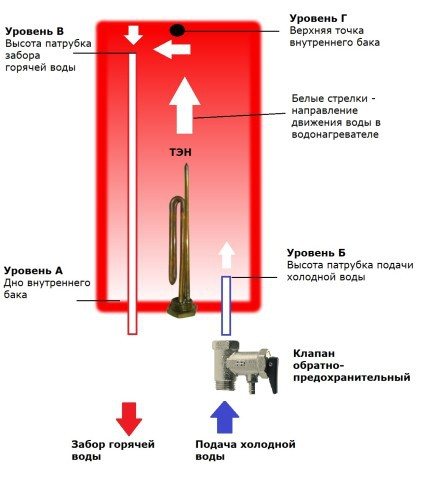

In most electric storage water heaters, temperature sensors are installed, with readings displayed on an electronic display or a mechanical thermometer. Cold water is supplied through a tap with a safety check valve. The boiler operating modes are controlled by both electronic modules and mechanical regulators in simpler models. The advantages of storage electric water heaters include the ability to heat large masses of water and low energy consumption, and the disadvantages are high cost.
How to turn on the boiler: step by step instructions, tips
New appliances in the house require studying the operating instructions.Boring occupation. Standing information is always hidden behind a pile of technical terms and is often difficult to digest.
But the correct and correct operation of the devices depends on this. To connect the boiler, you can call a specialist, but you can also save money and do all the work yourself.
We suggest that you familiarize yourself with the standard instructions for connecting the boiler. Everything is stated here, clearly and concisely.
Instructions for the first start-up of the boiler
The boiler is installed. Installation work was carried out by specialists or the owner, it does not matter. In any case, you need to check the operation of the system. To do this, following the advice given, you need start the heater for the first time.
- We start by checking that the systems are connected correctly, which are responsible for heating the water. Fidelity, reliability of the connection of the phase and zero wires, the presence of grounding. The functionality of the circuit breaker should also be checked. For this, a device is used - a tester or a special electrician's screwdriver.
- Next comes the search for leaks in the system.... It will be useful to control the connection of underwater pipes. Presence and diagnostics of the check valve operation.
- Running water into the boiler... Attention, the correct sequence of actions for the first and subsequent system starts will be described in the next section.
- Repeated search for water leaks in places of pipe installationb.
- Heater operation diagnostics... Turn on the device by pressing the power button.
- Fixing initial indicators temperature sensor.
- Rechecking after 15 minutes... The growth of indicators indicates the correct connection of the heating elements.
Sequencing
It is worth mentioning right away that the following the startup sequence is correct for both flow and storage heaters... A couple of nuances - in the case of the first type, you do not have to wait for the filling of the tank with water, and close the tap in the 2nd paragraph.
- Start by turning off the hot water supplywhich comes from the city supply system. If you skip this step, the water heated by the boiler will go into the common riser, regardless of the check valve.
- Opening the hot water tap... We are waiting for the remaining liquid in them to drain from the pipes. We close the tap.
- Two pipes go to the bottom of the boiler. One, marked with a blue ring, is underwater, the other, with a red marker, serves to supply hot water to the pipes.
- We open the valve on the underwater pipe... Water begins to flow into the storage device of the device.
- Next, we unscrew the second valve on the boiler... Allowing some water to go out into the pipes.
- Open hot water on the mixer... We are waiting for air to leave the system and an even stream of water flows. We shut off the water.
- We connect the heater to the electrical network and set the desired temperature regime.
In a home where there is no hot water supply, the first step must be skipped. Subsequent switching on of the heater will follow the same scheme. The only difference is in the 6th paragraph. Then, not air, but stagnant water will begin to come out of the heater tank.
Heating mode selection
We set the heating mode. The main thing in this matter is to set the water temperature that is comfortable for the user.... However, here are a few tips, the implementation of which will significantly extend the life of the device. Thus, save on future repairs.
- Set the temperature to 30-40 degrees as seldom as possible... Under these conditions, bacteria will grow rapidly inside the storage tank. This will create an unpleasant moldy smell. The walls will be covered with fungus, which is difficult to remove.
- Optimal operating mode, 55-60 degrees... In this temperature range, less scale will form on the heating element. Reduces the risk of mold. It is comfortable for human skin.
- Once a week, the boiler must be set to 90 degrees... Wait a couple of hours, and return to the previous regime. This is done to completely destroy bacteria in the storage tank.
- Some devices have an economical mode of operation. The heater in this case does not consume less electricity. The settings will be set as in point 2 and we are talking about reducing the risk of breakage.
- In the case of a flow-through type heater, the temperature is also controlled by water pressure.
Instructions for using the device
You can use the storage device immediately after the first start. To do this, you need to turn it on and select an operating mode. Throughout the entire operation, you will have to follow some rules. They will help to extend the life of the boiler.
- Before switching on, check the presence of water in the tank.... This will prevent the failure of the heating elements.
- It is recommended to install a filter on the pipe supplying water to the boiler.... It will protect against dirt and reduce water hardness.
- Descale the drive at least once a year.
- Periodically monitor the performance of the protective anode, change if necessary.
Flow type devices require compliance with several other rules.
- Check the water pressure before turning on the power... A weak jet will prevent the device from functioning properly.
- If the temperature is uncomfortable, adjust it using the buttons on the body or by turning the mixer tap.
- If the heater is installed in a bathroom, arrange splash protection.
- Hot water is no longer needed - be sure to turn off the device.
Both devices are not recommended to be installed in rooms where the temperature can drop below freezing. This will cause the water inside the appliance to freeze and break.
Equipment reliability depends not only on product quality. Also important: correct installation, switching on and use of technology. Compliance with the recommendations given in the article will significantly increase the uptime of the boiler.
Instantaneous water heater
The device of an instantaneous water heater is completely different from the operating principle of storage equipment. This device does not have a tank for storing water, and it is heated with a constant flow of liquid through the heating module. As such a module, a structure made of pipes with heating elements is used, which can be located both outside and inside the structure. The best material for making a heating module is copper, but in cheaper models stainless steel or aluminum can be used.
In addition to the module for heating water, the device includes various additional devices. A water flow sensor is required to determine the minimum water pressure at which the water heater can be operated. Temperature sensor, temperature controller (thermostat) are designed to control operating modes. A thermal fuse shuts down the system when the maximum possible water flow temperatures are exceeded. The picture below shows a classic cross-sectional diagram of an electric instantaneous water heater.
Electric water heater market overview
Currently, there are more manufacturers, both domestic and foreign, on the Russian market for electric water heating equipment. Of course, mainly foreign manufacturers such as MTS and Lorenzi Vasco dominate, but you cannot call their products pure imports. Most companies open their own full-cycle production facilities in Russia, with the manufacture of basic components. This allows you to reduce the cost of production and make it available to a wide range of buyers.One of these companies is the Italian corporation Thermex, whose products have practically become a Russian brand.
For more than twenty years it has been successfully working in Russia, opening its own factories and providing our market with high quality electric water heaters. The model range from this manufacturer includes all types of electrical equipment for water heating. The popularity of the Termex water heater among consumers is very high due to the innovative ideas used in its manufacture. The principle of operation of the Termeks water heater, regardless of the type of device, does not differ from similar products from other manufacturers. But it should be said right away that the company's products have won the trust of the Russian buyer with their technical characteristics and affordable prices.
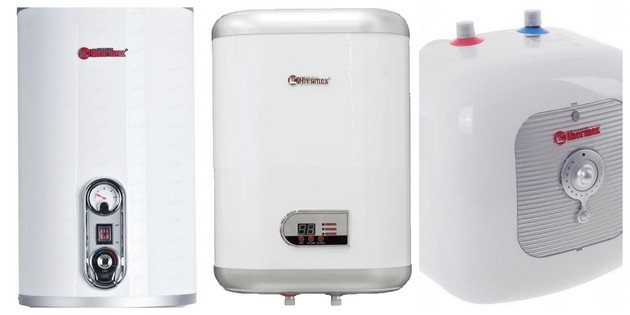

Why are water heaters from the "Termeks" corporation so good? Everything is very simple! The range of products is very wide and allows almost any consumer to choose equipment for heating water according to their needs. Electric storage water heaters Termeks are produced in a wide range of internal volumes from 10 to 300 liters. Flow-through heaters of various capacities allow you to almost instantly heat flowing cold water to the required temperature.
Other advantages of Termeks electric water heaters include the following technological and design features:
- the range of storage water heaters consists of both round and flat models of various sizes with a laconic design;
- high-quality thermal insulation of products and automatic control of operating modes can significantly save energy;
- in various models, both electronic and mechanical control are used, which makes it possible to optimize the entire process of heating water;
- storage water heater tanks are made of special stainless steel with high corrosion resistance;
- in instantaneous water heaters, the heating module is completely made of copper, which increases its reliability and durability;
- in some models of storage water heaters, the inner surface of the tanks is covered with bioglass porcelain, which completely eliminates the corrosion of the tank.
In addition, the product range includes electric water heaters with a combined water heating system.
The device and the general principle of operation of the storage water heater
The general device of a storage type water heater is the same for any model. The boiler consists of a water tank, which is enclosed in a decorative casing, and a heater is laid between them. It looks like a thermos. The main difference between storage boilers is what kind of heater they have: an electric heating element or a gas burner.
There are storage water heaters for indirect heating, where a coil connected to the heating system serves as a heater. Such boilers turned out to be practically not in demand. Heating does not work all year round, which means that a person does not have the opportunity to use hot water in summer.
Accumulative heaters differ according to the type of installation. Vertical boilers take up a lot of space, which is why they are placed in a spacious room. A horizontal water heater is more suitable for a small room. The last option is inconvenient in terms of use. In the case of a horizontal boiler, the hot and cold layers of water are quickly mixed. As a result, when the tap is opened, boiling water flows, and after about a minute, cooler water begins to flow.
General device of the boiler
Let's look at what the diagram of a conventional storage type water heater looks like:
- The boiler is based on a tank. In household models, its capacity is limited to 300 liters. The tank is made of stainless steel or steel.To prevent the metal from rusting, glass enamel, glass porcelain or titanium spraying is used as an internal coating.
- The water tank is enclosed in an external decorative casing. It can be made of stainless steel, ordinary enamelled steel or plastic.
- The space between the storage tank and the outer casing is filled with heat-insulating material - polyurethane foam.
- The front area of the outer casing of the water heater is equipped with a thermometer.
- The heart of the storage boiler is the heater. An electric water heater operates from a built-in element - heating element (tubular electric heater). Gas storage water heaters are equipped with a burner and a chimney.
- Hot and cold water pipes come out at the bottom of the storage boiler. A safety valve is installed on the cold water pipe, as well as a check valve. The first one opens from excess water pressure inside the tank. The second - does not allow water to leave the tank in the absence of pressure in the water supply system. The hot water pipe is connected to the intake pipe.
- The electronic unit is designed to control the operation of the storage water heater. It receives a signal from a thermostat, the sensors of which are installed inside the tank.
- The magnesium anode protects the steel tank of the boiler from galvanic corrosion by releasing ions.
Installation and operation of any storage water heater does not cause any difficulties for the user. The device is attached to the wall with brackets. The supply pipe can only be connected to a cold water supply. This is the principle of the boiler operation, since it is cold water that heats up in it. If the input of the storage water heater is connected to the centralized hot water supply of the apartment, then the correct temperature achievement after supplying the hot water to the tank will become impossible.
Principle of operation
The basic principle of operation of a storage water heater is the layer-by-layer separation of liquids of different temperatures. According to the law of physics, warm water is at the top and cold water is at the bottom. For a complete understanding of how the boiler works, consider all the steps in order:
- When you open the water tap, water starts to flow. The upper layers of hot liquid from the boiler tank are directed through the intake tube into the pipeline.
- The pressure inside the water heater tank becomes less than in the supply water pipe. The non-return valve opens and the cold water supply begins. When the pressure of the water supply and inside the tank is equal, the check valve closes. During make-up, cold water does not mix with hot water thanks to a divider installed at the end of the supply pipe.
- A sensor signals the entry of cold water into the water heater tank. He instructs the control unit to turn on the heating.
- Electricity is supplied to the heating element, and the water is heated to the set temperature. With a gas water heater, gas is supplied to the burner instead of electricity. When the water reaches the desired temperature, the thermostat turns off the heating element.
What are Ariston water heaters for?
If there is a collector in the system, a separate cold water supply pipe is thrown to the place of installation of the water heater. In the absence of a collector, the nearest section of the water pipe is cut, a standard tee is installed at the cut.
The installation method of the tee depends on the material from which the pipes are made. For plastic fasteners, it is carried out using a special soldering iron, for metal ones - with a thread.
A ball valve is installed in a separate section of the water supply system, designed to shut off the cold water supply.
Connection diagram of an electric storage water heater Ariston.
To connect the water heater to the water supply, you should:
- Pay attention to the hot and cold water pipes - it is important not to confuse them.A non-return valve is installed on a cold one; it can be included in the standard kit. Hot water is connected using a pipe. First, a cold water pipe is mounted, then a hot one.
- As a sealant and sealant, a special tape is wound on the thread, this is recommended by the manufacturer.
- A tee is installed on the cold water pipe, at the bottom of which there is a dump valve. A tap is attached to the side to completely drain the water from the tank in case of an emergency, possible due to abnormal pressure or heating. A shut-off valve and an adapter are installed under the tee at a short distance. The next step is to connect to the water supply.
- Connection to hot water is also made by installing a shut-off valve.
- In the case of joining different metals, adapters should be used.
We suggest that you familiarize yourself with Which dental floss is better waxed and unwaxed
The connection to the mains is carried out as follows:
- A separate automatic device (RCD) is installed in the switchboard, it is connected to the central automatic fuse. A three-core cable is pulled from a separate RCD to the boiler, which is placed in an external cable channel (or a special strobe is punched through the wall).
- It is recommended to install a 16 A fuse as the switch, as the socket and plug are exposed to heat and moisture. In addition, the cost of waterproof electrical equipment is higher than the cost of a machine. The "switch" is closed in a compact cabinet with a removable panel.
- A separate RCD and "switch" are connected with a wire.
- A three-core wire is connected to the heating element; for this, the lower panel is removed from the water heater.
- Then the vending machine output is connected to the boiler.
- The next step is to wire the ground, phase and zero lines to the appropriate connectors.
Diagram of connecting the Ariston water heater to the mains.
Before turning on the device, make sure that there are no leaks and that the flange is in the correct position (exactly in the middle). Then fill the tank with cold water and open the hot water tap to release the air. After the air has been deflated, the valve is closed and a test switch-on is carried out.
More detailed consultations and instructions for operation and installation can be obtained from the KVANTA company in Tyumen.
Electrical appliances, in particular an electric water heater, must be installed under conditions that are consistent with those specified in the operating manual.
As factors unacceptable for installation, the instructions for Ariston boilers are spelled out:
- frost - this is associated with the risk of water freezing in the tank and pipes;
- sunlight - do not expose the electric heater to direct sunlight;
- interruptions in voltage - the voltage in the network to which the device is connected must be stable;
- vapors, dust or gas - do not install the water heater in a room with a high concentration of dust and poisonous or acidic gases / vapors in the air;
- dampness - it is not recommended to install the device in conditions of constant dampness and in long-term unventilated rooms (this item depends on the degree of moisture resistance of the selected model of the water heater).
Scale on the heating element.
For repairs, it is preferable to use the services of professionals. Guides and advice on these matters can be obtained from QUANTA.
To carry out repair work, the user needs to notice a malfunction in the operation of the water heater in time. Ariston boilers are often equipped with an electronic display on which messages appear in the event of equipment failures.
Direct signs of a malfunction can be:
- activation of the machine at the moment the boiler is turned on - this indicates a malfunction of the heating element;
- heating water above the maximum permissible temperature - this indicates a failure of the thermostat;
- heating of water below the required indicators - this may indicate contamination of the heating element, the appearance of scale;
- drips in the bottom of the tank and on its walls;
- breakdown of the information board, which most often does not cause significant failures in the overall functionality of the device, however, it can reduce the comfort in the process of its use.
Extraneous noise during the operation of the electric heater can be considered an indirect sign.
So, on the modern market, heating boilers of the following types are offered:
- electric storage heaters;
- indirect heating boilers;
- gas boilers;
- flow heaters.
A large-capacity insulated tank (sometimes up to 1000 liters) has a built-in coil with a coolant supplied to it from the boiler. As in an electric boiler, cold water is supplied to the lower part of the tank, hot water is taken from the upper part. The unit is capable of providing a significant consumption of hot water, and therefore is used in private houses with a large number of consumers.
The usual exchange of heat between media with different temperatures is the principle of operation of an indirect heating boiler. But in order to get water from the tap with a temperature of 55 ºС, the boiler must heat the coolant to at least 80 ºС, this is one of the disadvantages of this water heater. The second drawback is the long loading time of a large-capacity tank, so in the case of intensive water withdrawal, people living in the house need to adapt to use hot water supply according to a certain schedule.
Like electric boilers, indirect water heaters are equipped with a magnesium anode to protect the steel tank from corrosion. More complex and expensive models are equipped with two coils, through one the coolant flows from the boiler, and the second can be connected to an alternative source of thermal energy.
Indirect heating units are manufactured in wall and floor versions, they can work with any sources of thermal energy. Boiler equipment manufacturers often offer them in conjunction with double-circuit boilers. In this case, the heat generator maintains the heating temperature and loads the boiler, alternately switching between the two systems.
As can be seen in the figure, heating is carried out not only from the burner, but also by taking the heat from the combustion products. This is achieved by a steel flue with diffusers passing vertically through the container and exchanging heat with water. The operation of the burner is controlled by an electronic unit, whose task is to extinguish or ignite it when the set temperature is reached or it drops. As usual, the boiler is designed with a magnesium anode to protect the body.
This type of water heaters is not very popular due to the difficulties in the design and connection of gas-using installations. In addition, a full-fledged chimney will be required to operate a gas boiler; it is not always possible or too expensive to fulfill this requirement.
We suggest that you familiarize yourself with the Basic rules for installing a duct fan
The heat sources are the same electric heating elements and gas burners, only they turn on after the hot water tap is opened in the house. These heaters include:
- gas water heaters;
- flowing electric heaters.
The advantage of flow-through water heating devices is that they can supply heated water without preparation and for an unlimited time. But its consumption has limits, which is important with a large number of consumers.
- body;
- tank protected by a special coating;
- magnesium anode;
- thermal insulation;
- combustion chamber, open or closed, or electric heating element;
- thermostat;
- for gas units an exhaust hood, gas burner;
- Control block;
- protection system;
- temperature sensor;
- safety valve;
- electrical cable (for electrical models);
- indicator light.
The principle of operation of storage water heaters is based on the fact that cold and hot water have different densities. So in the apparatus it is located in layers, below it is cold (it has a high density), above it is hot. Cold water enters and, without mixing with hot water, pushes it to the water intake point.
In this regard, you get a continuous flow of consistently hot water, without any disruptions in operation and unnecessary costs. Water heating is carried out thanks to a heating element or a gas burner, depending on the type of device. Accumulative models will provide consistently hot water from several water intake points.
The device and principle of operation of an electric boiler
Electric water heaters are considered the most popular among residents of apartments and private houses. The popularity is due to the ease of installation and operation. The diagram shows a sectional view of the storage water heater device. Let's take a look at what an electric boiler looks like from the inside:
- We will begin to consider the device of a storage electric water heater with a tank. It is round or oval in shape. The tank is enclosed in a decorative casing. The inner space between the two containers is filled with polyurethane foam.
- A feature of the electric water heater device is the presence of a heating element. The element is installed at the bottom of the boiler tank on a flange connection.
- The thermostat controls the heating element on and off. Any storage water heater works without exceeding the maximum permissible temperature. For electric boilers, this figure is 75 o C.
- The water heater is protected. In case of failure of the thermostat, the heating element will be de-energized when the critical water temperature reaches 85 o C.
- Hot water is drawn through a pipe, the end of which is brought out to the top of the boiler tank. A branch pipe is installed at the bottom of the tank for feeding cold water.
- The magnesium anode protects the tank body from corrosion. After 2-3 years, the element collapses and needs to be replaced.
- The operation of the water heater is signaled by an indicator lamp.
Knowing how the boiler works, you can understand its work. Cold water enters the inside of the boiler tank through the pipe. The sensor sends a signal to the control unit, which, using a thermostat, supplies voltage to the heating element. The water heats up to the set temperature. The sensor gives a new signal and the thermostat interrupts the power supply. After drawing hot water, the cycle repeats.
Varieties of heating elements
According to the principle of operation, the heating elements are the same. A spiral acts as a heating element. But according to the execution of the heating elements, they differ and are divided into two types:
- Wet heating element consists of a spiral, hermetically sealed inside a copper tube. Quartz sand is used as a filler. It acts as an insulator and prevents the coil from touching the inner walls of the copper tube. The advantage of wet heating elements is low cost. The disadvantage is its large size and low electrical safety indicator. If the copper tube is damaged or the coil touches it, a breakdown occurs. As a result, a person using hot water receives an electric shock.
A storage water heater with a dry heating element is more expensive, but it is safer and has a long service life. Compact dimensions allow two heaters to be installed in the boiler. The most reliable is a dry heating element, the typesetting body of which is made of soapite.
Solar Boiler Device
The best option for saving energy is a solar boiler. In addition, this type of heater is more durable and reliable. Therefore, special attention should be paid to how the solar boiler works.
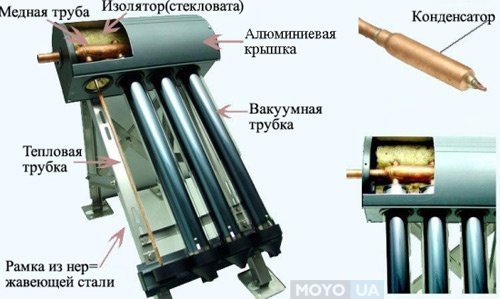

The main element of the installation is the collector. This is, in fact, a radiator, only working in the opposite way.It represents a system of thin tubes that are installed at an angle to the horizontal of the slab. The coolant circulating through them absorbs the energy of the sun. Tubes are pre-coated with a selective coating on the inside for more reflectivity. Usually 3-4 coats are applied. The efficiency of work and the rate of heating of water often depends on the coating.
The boiler also includes a tank. With the help of this unit, the consumption of the coolant is carried out. The reservoir also serves as a expansion tank and a heat accumulator or its exchanger, which depends on the design features. These heaters are suitable for both home and commercial use.
The device and principle of operation of a gas appliance for heating water
In terms of the structure and principle of operation, a gas boiler is slightly different from its electric counterpart. The same tank enclosed in a casing with polyurethane foam insulation is inherent in a gas water heater. The anode serves as protection. Cold water is supplied and hot water is drawn through the pipes mounted in the tank. The heating is switched on and off by a thermostat. This is where all the similarities end. Guided by the diagram, we will take a closer look at the boiler device in order to identify the main differences between the gas appliance:
- The main difference from an electric boiler is the presence of a gas device for heating water - a burner.
- The connection to the gas main is carried out through the block. A reducer is installed inside it, which is connected by a tube to the burner nozzle.
- The design of the storage water heater tank differs significantly from the electric analogue by the presence of a chimney. It consists of a steel pipe welded vertically through the entire tank. From above, the chimney is connected to an exhaust hood. Through it, the combustion products are discharged to the street.
- A splitter is installed inside the chimney. Its plates take away the heat of the exhaust gases and give it back to the water. It turns out double heating: from the burner and the divider.
- Due to the temperature difference between the cold water and the burner flame, condensation forms in the chimney. To collect it, a ring is installed under the burner.
A gas water heater works according to the same principle as an electric boiler. The only difference is that an electronic unit with a thermostat controls the operation of the burner. When the temperature drops, gas is supplied to the nozzle and ignition occurs. When the water temperature reaches the set parameters, the burner shuts down.
Gas water heaters are in low demand due to the complexity of the installation. It will be necessary to draw up a project, and installation is allowed only by specialists of the gas service. However, the indisputable advantage is the savings due to the lower gas price.
Of the two options considered, the first place is given to electric storage water heaters. The device can be independently installed in any place. The main thing is to ensure an uninterrupted supply of cold water under pressure.
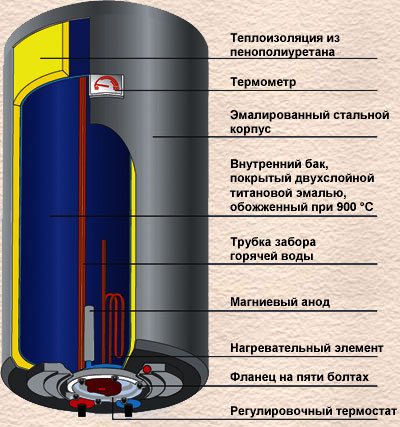

An electric storage-type water heater, or, in a simple way, a boiler, has long and firmly entered our life, providing additional comfort and allowing you not to depend on communal hot water supply systems. This simple device automatically maintains the required water temperature, while having a certain supply of it. The devices produced by the industry have a variety of shapes, sizes and external designs. Despite the apparent differences, at their core, all water heaters have a similar design and a single principle of operation. However, when making a choice between a particular model of a boiler, one should not only understand how it works, but also understand the features of the execution of some of its components.
Pros and cons of boilers
The boiler can be used to heat a large volume of water
In the absence of a centralized hot water supply system, it is boilers that are used.Their advantages include the following points:
- Ease of use.
- Large volumes can be heated.
- One device can be used to supply several rooms.
- The operation of the device does not depend on the force of pressure.
- Possibility of heating to high temperatures.
- Retention of high temperature for a long time due to high-quality thermal insulation of the tank.
Large boiler requires a lot of space
Among the disadvantages are the following:
- Long time for initial heating.
- If the water flow is low, maintaining a constant temperature will incur energy costs.
- A large tank requires ample space.
- The cost is higher than that of a flow-through product.
In case of problems with the water supply, you can put a boiler in an apartment building. The device and principle of operation will depend on the type of device, its functionality and additional functions.
Boiler design
In fact, any water heater of this type is a large thermos with a tubular electric heater (TEN) inside, so the design of all boilers has the following elements:
- external case with parts that allow the device to be mounted on a wall or floor;
- internal tank;
- a heat-insulating layer between the inner container and the body;
- tubular electric heater;
- thermostat with the ability to adjust the heating temperature;
- safety valve;
- protective magnesium anode;
- control and indication circuit.
When choosing a boiler, one cannot fail to notice a big difference in price, even between different models of the same manufacturer. It is primarily due to the technology and material used to manufacture the internal tank, as well as the presence of an electronic control and display unit.
These parameters determine the convenience of using the device, as well as the duration of its service.
Recommendations on how to economically use the boiler
The boiler is a fairly expensive device. Every owner learns about this when it comes time to pay for electricity. That is why there are a number of recommendations for saving electricity.
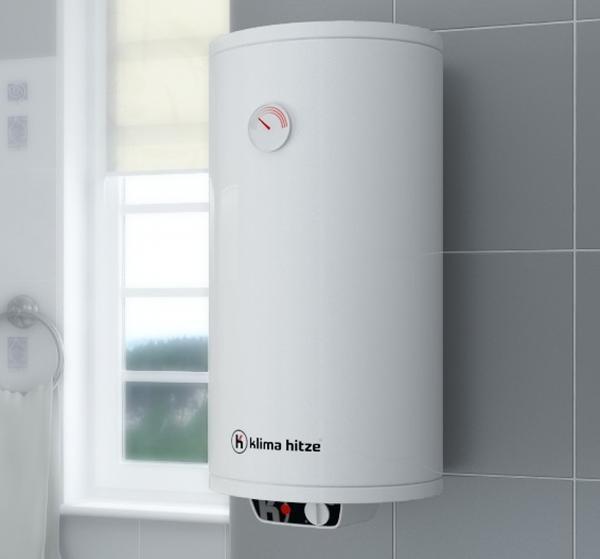

Rules for the budgetary use of the boiler:
- It is not necessary to turn off the water heater if hot water is constantly needed. When the boiler maintains a constant temperature, less energy is consumed than heating it each time from the beginning.
- If hot water is needed less often than a couple of times a day, then it is better to turn off the boiler.
- Some models have an economy mode.
Expert advice will help you choose the right model:
But the main thing is that you need to save water itself. You don't need it to flow unnecessarily. Heating is fast enough, and closing the tap for a few minutes during the procedure will save money.
Housing
Cases of water heaters have both strictly cylindrical and oval and even rectangular shapes, various colors and design designs. Often a thermometer is attached to the outside of the housing to monitor the operation of the device, as well as regulators or control elements. The housings are made of steel sheet or plastic.
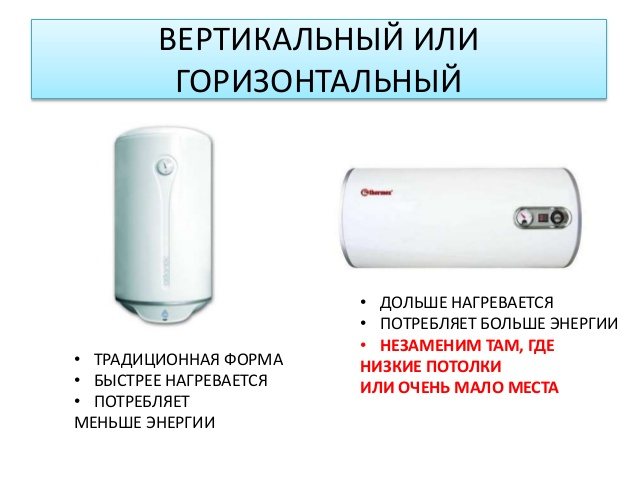

Features of vertical and horizontal boilers
Inner tank
The design of the internal tank of the boiler must meet the criterion of increased corrosion resistance and at the same time withstand constant temperature changes, therefore, manufacturers pay a lot of attention to this element, developing new tank coatings and applying methods of its protection.
Steel tanks coated with glass enamel or glass porcelain
Such a coating is obtained by spraying a protective layer with its subsequent firing at a high temperature (up to 850 ° C). Glass enamel is not capable of oxidation, therefore it does not corrode at all. In addition, its smooth surface resists limescale build-up.
Paradoxically, the main disadvantage of such a coating stems from its advantage - the high hardness of the layer is low-plastic and over time, constant changes in water temperature lead to the formation of microcracks in its layer, which ultimately contribute to the destruction of the tank.
Manufacturers are constantly looking for new formulations for this type of coating. For example, the addition of titanium powder equalized the temperature coefficients of expansion of glass porcelain and steel, slightly improving the resistance of the layer to cracking. It is possible to slightly reduce the harmful effect of temperature exposure by setting the water temperature in the boiler to no higher than 70 ° C, although all the same, at least once a month, you will have to warm up the device as much as possible in order to comply with sanitary rules. Another disadvantage of the glass-porcelain coating of the tank can be considered the increased weight of the boiler. Companies producing water heaters with tanks of this type give a guarantee for their products for no more than 3 years.
Titanium coated steel tanks
By spraying titanium powder onto the inside of the tank, excellent corrosion resistance is achieved. At the same time, this type of coating has high strength and mechanical resistance, having weak points only at the welding joints. The warranty for a device with such a tank is up to 10 years, which is a huge advantage, even if you take into account its rather high cost.
Stainless steel inner tanks
Such containers are devoid of the disadvantages of the two previous elements. Stainless steel, like titanium, is able to withstand the effects of impurities in the water, as well as corrosion. It is believed that stainless steel gives water a peculiar smell and taste that appear during its heating, but this is just speculation, absolutely not confirmed by scientific research. It is known that "stainless steel" does not enter into a chemical reaction with water. Manufacturers also give up to 10 years warranty for such tanks, but they are the most expensive ones. Tanks made of stainless steel, as well as those with titanium spraying, are more susceptible to scale formation than glass porcelain, but this does not detract from their merits in the least. The inner tank contains pipes for supplying cold water and removing hot water, as well as an electronic heating and protection unit.
A way to make the boiler economical. The need for on-off
A few words about how to make a boiler economical. For a family of 2, a 50 liter heater is sufficient. Automation is adjusted to the upper limit of 70 ° C and the lower one - 50 ° C. The device will turn on every few hours for 10-15 minutes during idle time. As a result, consumption will be 1-2 kW in 24 hours, 40-60 kW per month.
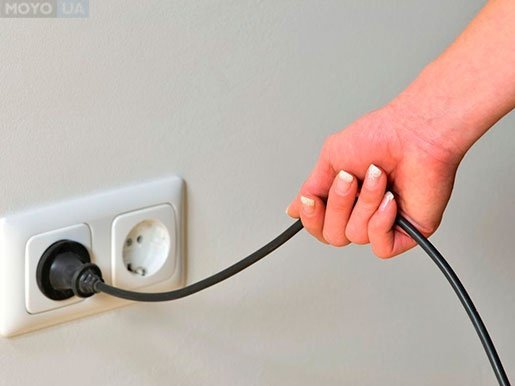

Do I need to turn off the boiler? Such devices are equipped with a thermostat and are automatically turned off in case of network failures. If the water heater is turned off from time to time, electricity consumption will increase. This is due to the fact that the installation will require much more resources to warm up. A switched on boiler simply maintains heat, like a thermos. Simple physical laws - the greater the difference in temperature readings, the faster the water in the installation will cool down. The less - the slower. The device directly operates in the on-off mode of water heating. That is, when the temperature reaches the set value, the device stops functioning. After the lapse of time, the water temperature drops. The boiler works in a cyclical manner, as it is equipped with a sensor and a regulator. The only thing that needs to be done is to turn it off when leaving for a long period for safety reasons. In addition, permanent disconnection from the mains significantly reduces the service life. Consequently, it is more profitable when the device operates from the network all the time, which at the same time has a positive effect on the durability of the equipment.
Heating and protection unit
The elements responsible for heating water to a certain temperature, as well as protecting the metal of the inner tank from destruction, are installed on a metal flange, which is connected by means of a seal to the inner tank of the device.
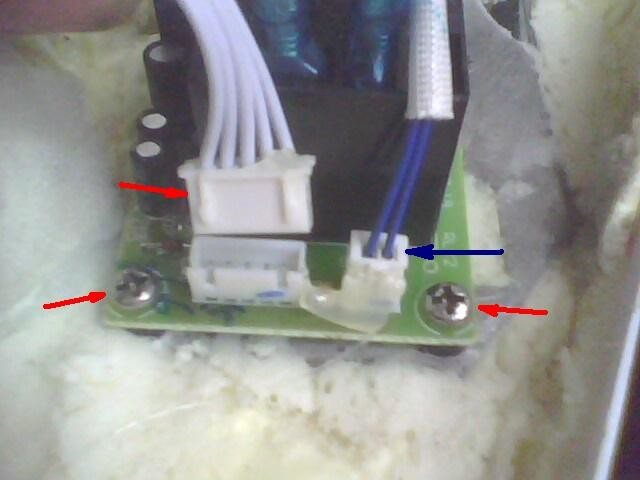

An example of a control unit
Heating elements of various capacities are used to heat water. Depending on the heating principle, a distinction is made between:
- "Wet" heating elements, which are in direct contact with water, therefore inevitably become covered with scale, which must be periodically removed, otherwise the heating element will fail due to overheating;
- dry type heaters. Devoid of this drawback, since they are installed in a metal tube, which makes contact with the liquid. This scheme allows you to get rid of scale not only on the heater, but also on the tube covered with a layer of glass porcelain.
Some boiler models are equipped with several heaters. This design allows for stepwise regulation of heating, and also reduces the number of switching cycles for each of them (voltage surges during switching on of devices affect their durability).
Together with heating elements, a thermostat and a magnesium rod (anode) are installed on the flange. The thermostat is responsible for turning on the heating element when the water temperature drops below the set by the consumer. Thermoregulators of both mechanical type and electronic devices operating in conjunction with an electronic control unit are used. Often, the thermostat device includes a safety shutdown circuit for the heating element in the absence of water in the tank. The magnesium electrode is designed to reduce the exchange of ions of metal components inside the boiler, giving back its particles in return. This scheme reduces the effect of leaching electrons from structural elements and they corrode to a much lesser extent. At the same time, the magnesium rod itself collapses rather quickly and requires periodic replacement (when thinning to 10 mm or reducing the length to 200 mm). The control and indication circuit provides additional convenience when using the water heater, having the functions of precise adjustment of the water temperature, switching on heating by time, maintaining a different degree of heating depending on the time of day.
The sequence of actions for turning on the boiler, rules of use
Having bought a new heater, you need to study the instructions. It provides detailed information on the operation of the device. You can turn on the device yourself. How to turn on the boiler will be described in the article.
System check at the first start of the water heater
It is important that you follow the procedure for turning on the heater correctly. How to turn on the water heater correctly is described below.
After installing the device, you need to check the operation of the system. To do this, you can use the following recommendations:
- Check the connection of the water heating systems. Inquire about the operation of the fuse, about the presence of grounding in the house. It also does not hurt to check the reliability of the fastening of all elements. The process may require a multimeter.
- Check pipes for leaks. If they are identified, the problem should be corrected immediately.
Running water
Before switching on, two pipes must be connected to the device: an underwater one and a pipe through which hot water flows. Then open the tap located on the mixer.
Functional check
To diagnose the water heater, you need to press the power button several times. If defects are found during the check, you must contact the service, whose specialists will be able to repair the device.
Initial indications
When the water heater is connected to the mains, all the necessary information will appear on its display. Information about the temperature and power of the device will be presented. They can always be adjusted to turn on the water heater as the regulations dictate.
Additional Information! Read more in the instructions that come with the kit.
Re-check
Repeat the cycle of turning on the device several times. In the process of performing this procedure, malfunctions may occur, which indicate that the water heater needs to be returned to the service center for service.
Startup sequence
To answer the question of how to start the boiler, you need to sequentially perform certain actions. Moreover, this rule applies to both storage and flow-through boilers. To accomplish the task, it is better to follow the algorithm:
- Shut off DHW. Ignoring this action will lead to the fact that the water heated by the device during operation will go into the common riser.
- The first start-up of the water heaters must be accompanied by the opening of the hot water supply tap. Next, you need to wait until the remnants of it drain from the pipes. This will take a few seconds.
- The lower part of the water heaters is equipped with two openings for connecting pipes. The first pipe is underwater. On the boiler, this hole is circled in blue. The second is responsible for supplying hot water. Marked in red. To start the boiler, both the first and the second pipe are needed.
- Open the tap located on the underwater pipe. After completing this procedure, water will begin to flow into the storage tank of the boiler.
- There is a faucet on the side of the device, which is responsible for distributing water throughout the device. It will also need to be opened.
- Open the hot water tap on the mixer.
- Connect the device to the mains. Make the necessary settings.
Note! Some houses are still not supplied with hot water. In such a situation, the first point should be ignored. Further switching on of the heater will take place in the same sequence. The sixth step will also change. This will drain the remaining water from the tank.
After completing the above steps, the water heater will be ready for operation.
Tips for choosing a heating mode
It is generally accepted that a low heating temperature saves electrical energy. However, this opinion is erroneous. When this function is enabled, the efficiency of the water heater decreases sharply. As a rule, modern boilers are equipped with a special function that allows you to save energy. You can enable it by pressing the corresponding button on the instrument panel.
Saving mode prevents the heater from exceeding the 50 degree limit. At the same time, scum practically does not form inside the device.
Important! If the water heating temperature is less than 50 degrees, then bacteria will begin to multiply in the boiler. Thus, the quality of the water will deteriorate.
Basic rules for using the boiler
It is important to correctly turn on the water heater of both flow and storage type. Each device must be operated based on the characteristics of its structure. Next, we will focus on the methods of operating the heaters.
How to use a storage device for heating water
There are several requirements that must be observed when using a storage type water heater.
- The use of the boiler at negative temperatures is prohibited. At the same time, the air temperature in the room where the water heater is located should not fall below +5 degrees. This fact is especially relevant for those who buy a boiler for use in the country.
- When connecting the device to the mains, check for the presence of water inside the tank. Its absence will lead to a breakdown of the device.
- Before turning on, you need to buy an uninterruptible power supply. Sudden voltage fluctuations will adversely affect the operation of the unit.
How to use a flow type water heater
There is no container for heating water in such devices. Heating occurs when fluid flows through the heating elements.When using an instantaneous heater, it must be borne in mind that, due to the high pressure, the water will not be able to warm up.
Note! During the operation of the device, you need to install a special filter that is able to purify chlorinated water. Bleach will quickly ruin the internal parts of the device. It is highly discouraged to use the device at low temperatures.
Recommendations for turning on the boiler
Depending on the type of water heater, there are several options for switching on the water heater. How to include the most famous brands of devices will be discussed later.
Launching the water heater "Ariston"
After connecting the device to the mains, you must proceed according to the following algorithm:
- Pay attention to the indicators that should light up on the instrument panel.
- Blinking temperature lights indicate that the water heater is not working.
- Press the button responsible for starting. Most often, this key is located in the extreme corner of the panel.
- Adjust the required temperature using the appropriate keys.
- Set the required power. On boilers from this parameter does not exceed 2500 W.
Additional Information! Most water heaters automatically retain their original settings. Therefore, in the future, you will not have to adjust the water heater.
How to start a water heater "Electrolux"
There are several steps that need to be performed to turn on a boiler of this brand:
- Connect the device to the network.
- Press the Power key.
- After completing the above steps, the display of the device will turn on.
- Adjust indicators: temperature mode, heating power.
- Press the button "Save selected parameters"
Important! Most of the heaters "Electrolux" initially have the "Energy saving" mode active. Some users can disable this feature by going to the device settings.
Following the recommendations that have been outlined in this article, you can significantly increase the durability of the boiler.

